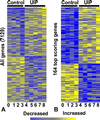Gene expression analysis reveals matrilysin as a key regulator of pulmonary fibrosis in mice and humans
- PMID: 11983918
- PMCID: PMC122942
- DOI: 10.1073/pnas.092134099
Gene expression analysis reveals matrilysin as a key regulator of pulmonary fibrosis in mice and humans
Abstract
Pulmonary fibrosis is a progressive and largely untreatable group of disorders that affects up to 100,000 people on any given day in the United States. To elucidate the molecular mechanisms that lead to end-stage human pulmonary fibrosis we analyzed samples from patients with histologically proven pulmonary fibrosis (usual interstitial pneumonia) by using oligonucleotide microarrays. Gene expression patterns clearly distinguished normal from fibrotic lungs. Many of the genes that were significantly increased in fibrotic lungs encoded proteins associated with extracellular matrix formation and degradation and proteins expressed in smooth muscle. Using a combined set of scoring systems we determined that matrilysin (matrix metalloproteinase 7), a metalloprotease not previously associated with pulmonary fibrosis, was the most informative increased gene in our data set. Immunohistochemisry demonstrated increased expression of matrilysin protein in fibrotic lungs. Furthermore, matrilysin knockout mice were dramatically protected from pulmonary fibrosis in response to intratracheal bleomycin. Our results identify matrilysin as a mediator of pulmonary fibrosis and a potential therapeutic target. They also illustrate the power of global gene expression analysis of human tissue samples to identify molecular pathways involved in clinical disease.
Figures



References
-
- Costabel U, King T E. Eur Respir J. 2001;17:163–167. - PubMed
-
- Ryu J H, Colby T V, Hartman T E. Mayo Clin Proc. 1998;73:1085–1101. - PubMed
-
- King T E., Jr Ann Intern Med. 1998;129:806–812. - PubMed
-
- Coker R K, Laurent G J. Eur Respir J. 1998;11:1218–1221. - PubMed
-
- Selman M, King T E, Pardo A. Ann Intern Med. 2001;134:136–151. - PubMed
Publication types
MeSH terms
Substances
LinkOut - more resources
Full Text Sources
Other Literature Sources
Medical
Molecular Biology Databases

